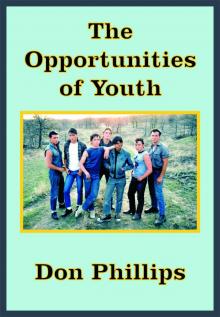- Home
- Donald Phillips
The Opportunities of Youth
The Opportunities of Youth Read online
The Opportunities of Youth
Copyright © Don Phillips 2005
No part of this publication may be used as a story line for any kind of moving pictures, video or animation without the express permission of the author.
Dedication
This book is dedicated to all the trainees of the Special Unit of Avon County’s Youth Opportunities Scheme. They know who they are.
Prologue
This book is a comedy, but the reader needs to understand a little of the background of Youth Opportunities as they were known.
In the late seventies the Thatcher Government determined for once and for all to destroy the power of the Trade Unions who they felt were holding the country to ransom and to be fair, the majority of people in the country at least half agreed with her. However, what the Thatcherites actually achieved with their monetarist policies was the destruction of the countries manufacturing base, which slid rapidly downhill and has been diminishing ever since. Apprenticeships and other types of trade learning practically vanished overnight as companies cut down on all possible expenditures and then went to the wall in droves, buried under an interest rate that finally topped out at eighteen percent as Thatcher determinedly pursued her policies.
There is no doubt that this did severely curb Union power. However, it also removed the livelihood and job opportunities of thousands upon thousands of school leavers. This was especially true for the less able kids who had relied on jobs in the manufacturing industries. And so in Avon County, now vanished from the face of the earth, ACYOPS was invented, Avon County Youth Opportunities Scheme, to give these unemployed kids something to do. The idea was that they should be paid a minimum wage by the state and placed with kindly employers who would teach them the ropes in return for their prepaid labours. In other words free workers from the government in return for giving them real world experience. Some, the more able, were put straight with employers. The rest were first of all put with Supervisors in groups to learn such skills as building and painting and decorating.
They practised on community halls, church halls and other buildings whose owners were very happy to have the work done, however slowly, for only the cost of the materials. To carry out this work of placing and administrating YOPS a whole new department was needed by most County Councils and then they had to be staffed. For old builders whose bodies were giving out before retirement could rescue them, it was a godsend and these people did a good job in teaching a difficult client group how to survive on a building site. Other private schemes were also sanctioned in all sorts of areas of employment. Some were incredibly good, but many were just bloody awful.
In all these schemes the sponsoring body had complete freedom in the matter of choosing staff and no common criteria was ever issued by government nor were the qualifications claimed by the applicants ever really properly checked.
Many schemes had absolutely nobody who had any experienced in training youngsters for work at all and many supervisors were taken from the ranks of ex-teachers. This was not very successful as this group had tended to spend six years training to be teachers only to find what a difficult job it is to teach thirty or more teenagers at a time, especially if they had not the slightest interest in your subject. These people then abandoned the teaching profession for anything they could get their hands on, including ACYOP. Because they had been to teaching college for six years learning a job they now discovered they didn’t want, they found themselves fast approaching thirty and totally unsuited to placing sixteen year old kids into the world of work that they themselves had never experienced. None the less, despite their rejection of the teaching profession dozens of these failures, I can use no other word, were employed to become ACYOP supervisors with absolutely predictable results.
Finally there was a group of youngsters that nobody knew what to do with. These were the special needs trainees, as they would be called now. In those days we were less politically correct and a lot more honest. These kids were known in the trade as the Sad, the Mad and the Bad. The sSad were the educationally subnormal, yes, that is how they were called then, and those kids who had found themselves in care for some reason or other and without a normal home. The second group were the Mad and they were the ones who for some reason were out of kilter with the rest of the world. Teachers and parents had given up on them and they were left in limbo. The last group were the Bad. Those kids who had crossed swords with the law and had been offered the choice of a custodial sentence or ACYOPS.
Of course it was not quite as clear-cut as that. Some kids fell into more than one category while others embraced all three. Sent along by Social Services, Probation, Police, schools and any one else who had a school leaver they did not know what to do with, these were the clients of the Special Unit and these are the kids around whom much of this story revolves.
By now some of the more politically correct among you will be getting jumpy at my continually calling them kids. Well we tried all the politically correct titles. We tried calling them clients and we tried referring to them as Youths and Young Persons. They laughed at us and said it was bollocks, so we went back to calling them what they called themselves, Kids. I had over seven hundred pass through my hands. Six hundred and ninety six of them were saveable. Four of them should have been shot. Not a bad ratio really.

 Four Short Tales
Four Short Tales The Opportunities of Youth
The Opportunities of Youth Vengeance
Vengeance Cocaine
Cocaine